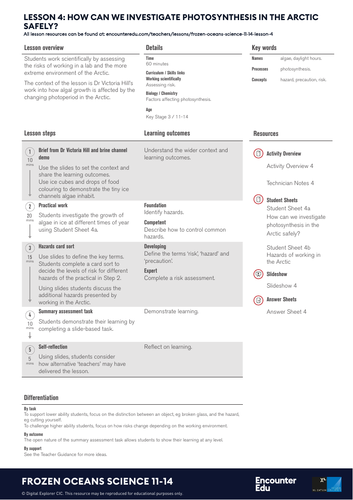






Students work scientifically by assessing the risks of working in a lab and the more extreme environment of the Arctic.
The context of the lesson is Dr Victoria Hill’s work into how algal growth is affected by the changing photoperiod in the Arctic.
This full lesson contains:
Slideshow 4: How do we investigate photosynthesis in the Arctic safely?
Lesson Overview and Teacher Guidance
Activity Overview 4: How do we investigate photosynthesis in the Arctic safely?
Student Sheet 4a: How do we investigate photosynthesis in the Arctic safely?
Student Sheet 4b: Hazards of working in the Arctic
Six enquiry-based lessons introducing ocean science concepts for ages 11-14.
These lessons and activities are full of practical ideas to bring carbonate chemistry and marine biology to the science classroom. All lessons demonstrate science at work and are based on recent research conducted in the Arctic. Designed to be used in conjunction with the Encounter Edu Media Zone. All lessons and resources are available from Encounter Edu’s TES profile.
Something went wrong, please try again later.
This is amazing! Great resource to develop thinking and investigative skills
Report this resourceto let us know if it violates our terms and conditions.
Our customer service team will review your report and will be in touch.